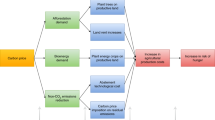Abstract
This study uses the concept of shadow prices formeasuring the impacts of climate change. By estimatinga restricted profit function rather than a cost or aproduction function the explanatory power of the modelis increased because of an endogenous outputstructure. Using low aggregated panel data on WesternGerman farmers, the results imply that the agricultural production process is significantly influenced by climate conditions. Simulation results using a 2 ×CO2 climate scenario show positive impactsfor all regions in Germany. Interestingly, the spatialdistribution of the gains is indicating no advantagefor those regions, which currently suffer frominsufficient temperature. Finally, the importance ofan endogenous output structure is confirmed by thefinding that the desired product mix will drasticallychange.
Similar content being viewed by others
REFERENCES
Adams, R. M., R. A. Fleming, C. C. Chang, B. A. McCarl and C. Rosenzweig (1993),A Reassessment of the Economic Effects of Global Climate Change on U.S. Agriculture. Report for the U.S. Environmental Protection Agency, Washington DC.
Carter, T., N. T. Konijn and R. Watts (1988), ‘TheChoice of First-Order Impact Models’, in M. L. Parry and T. R. Carter, eds., The Impact of Climatic Variations on Agriculture, Volume 1: Assessments in Cool Temperate and Cold Regions. Dordrecht: Kluwer Academic Publishers, pp. 97–123.
Cline, W. R. (1992), The Economics of Global Warming.Washington: Institute for International Economics.
Diewert, W. E. and T. J. Wales (1987), ‘FlexibleFunctional Forms and Global Curvature Conditions’, Econometrica 55, 43–68.
Dixon, B. L., S.E. Hollinger, P. Garcia and V. Tirupattur (1994), ‘Estimating Corn Yield Response Models to Predict Impacts of Climate Change’, Journal of Agricultural and Resource Economics 19, 58–68.
Easterling, W. E.,M. S. McKenney, N. J. Rosenberg and K. M. Lemon (1992), ‘Simulations of Crop Response to Climate Change: Effects with Present Technology and currently available Adjustments’, Agricultural and Forest Meteorology 59, 75–102.
Greene, W. H. (1997), Econometric Analysis, 3rd edn. NewJersey: Prentice Hall.
Kane, S., J. Reilly and J. Tobey (1992), ‘An Empirical Study of the EconomicEffects of Climate Change on World Agriculture’, Climatic Change 21, 17–35.
Kattenberg, A.,F. Giorgi, H. Grassl, G. A. Meehl, J. F. B. Mitchell, R. J. Stouffer, T. Tokioka, A. J. Weaver and T. M. L. Wigley (1996), ‘Climate Models — Projections of Future Climate’, in J. T. Houghton, L. G. M. Filho, B. A. Callander, N. Harris, A. Kattenberg and K. Maskell, eds., Climate Change 1995: The Science of Climate Change, Second Assessment Report of the Intergovernmental Panel on Climate Change I. Cambridge: Cambridge University Press, pp. 285–357.
Kelly, D., C. Kolstad and G. Mitchell (1999), Adjustment Costs fromEnvironmental Change Induced by Incomplete Information and Learning. Department of Economics, University of California, Santa Barbara.
Lang, G. (1999), Globaler Klimawandel und Agrarsektor, Schriften zurangewandten Wirtschaftsforschung 80. Tübingen: Mohr-Siebeck.
Lau, L. (1978), ‘Testing and ImposingMonotonicity, Convexity and Quasi-Convexity Constraints’, in M. Fuss and D. McFadden, eds., Production Economics: A Dual Approach to Theory and Applications. Amsterdam: North-Holland, pp. 409–453.
Livernois, J. B. and D. L. Ryan (1989), ‘Testing for Non-Jointness in Oil and Gas Exploration: A VariableProfit Function Approach’, International Economic Review 30, 479–504.
Mendelsohn, R., W.D. Nordhaus and D. Shaw (1994), ‘The Impact of Global Warming on Agriculture: A Ricardian Analysis’, The American Economic Review 84, 753–771.
McFadden, D. (1978), ‘Cost, Revenue, and ProfitFunctions’, in M. Fuss and D. McFadden, eds., Production Economics: A Dual Approach to Theory and Applications, Vol. 1. Amsterdam: North-Holland, pp. 1–110.
Pearce, D. W., W. R. Cline, A.N. Achanta, S. Fankhauser, R. K. Pachauri, R. S. J. Tol and P. Vellinga (1996), ‘The Social Costs of Climate Change: Greenhouse Damage and the Benefits of Control’, in J. P. Bruce, H. Lee and E. F. Haites, eds., Climate Change 1995: Economic and Social Dimensions of Climate Change, Second Assessment Report of the Intergovernmental Panel on Climate Change III. Cambridge: Cambridge University Press, pp. 181–224.
Reilly, J. (1996), ‘Agriculture in a Changing Climate: Impacts and Adaptation’, in R.T. Watson, M.C. Zinyowera and R. H. Moss, eds., Climate Change 1995: Impacts, Adaptations and Mitigation of Climate Change, Second Assessment Report of the Intergovernmental Panel on Climate Change II. Cambridge: Cambridge University Press, pp. 427–467.
Reilly, J. and N. Hohmann (1993), ‘Climate Change and Agriculture:The Role of International Trade’, The American Economic Review 83, 306–312.
Smith, J. B. andD. A. Tirpak (1990), The Potential Effects of Global Climate Change on the United States. New York: Hemisphere Publishing Corporation.
Strain, B. R. and J. D. Cure (1985), Direct Effects ofIncreasing Carbon Dioxide on Vegetation. Washington: US-Department of Energie (DOE/ER-0238).
Talpaz, H., W. P. Alexander and C. R. Shumway (1989), ‘Estimation of Systems of Equations Subject toCurvature Constraints’, Journal of Statistical Computation and Simulation 32, 201–214.
Weaver, A. J.and C. Green (1994), Global Climate Change and Variability: Action or Adaptation to Increasing Greenhouse Gases? — Lessons from the Past. McGill University: Report 94-1.
Wolf, J. (1993), ‘Effects of ClimateChange on Wheat Production Potential in the European Community’, European Journal of Agronomics 2, 281–292.
Author information
Authors and Affiliations
Rights and permissions
About this article
Cite this article
Lang, G. Global Warming and German Agriculture Impact Estimations Using a Restricted Profit Function. Environmental and Resource Economics 19, 97–112 (2001). https://doi.org/10.1023/A:1011178931639
Issue Date:
DOI: https://doi.org/10.1023/A:1011178931639




